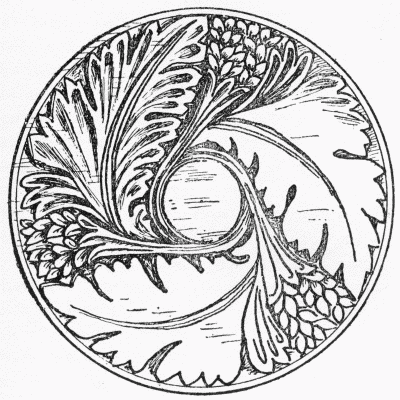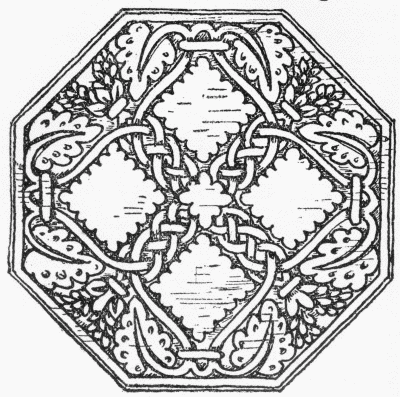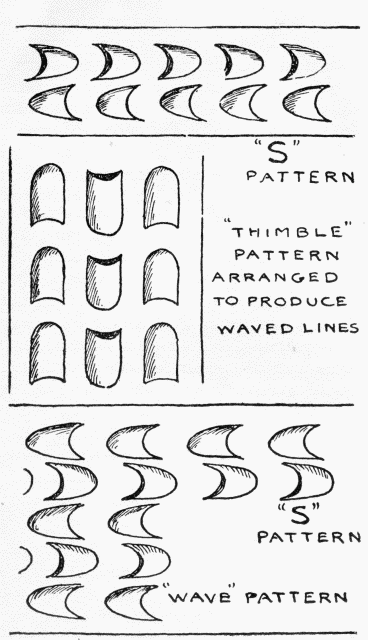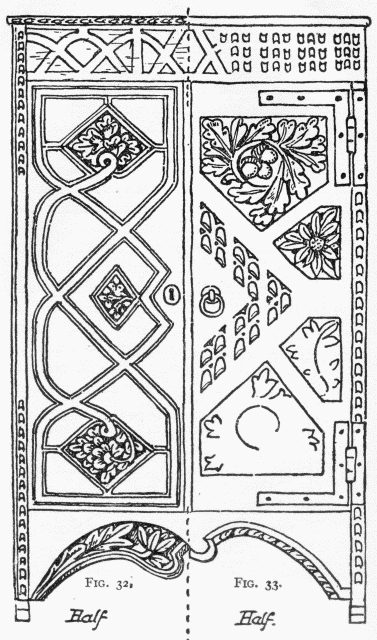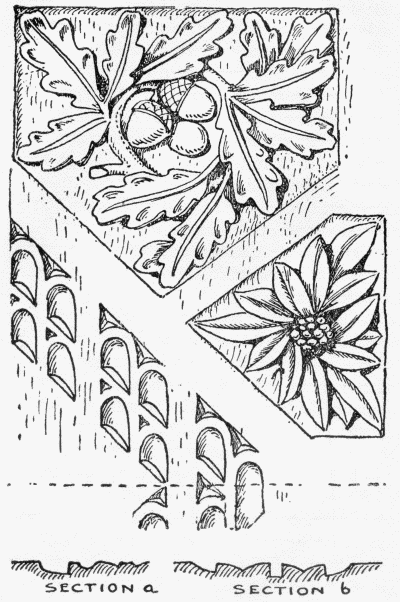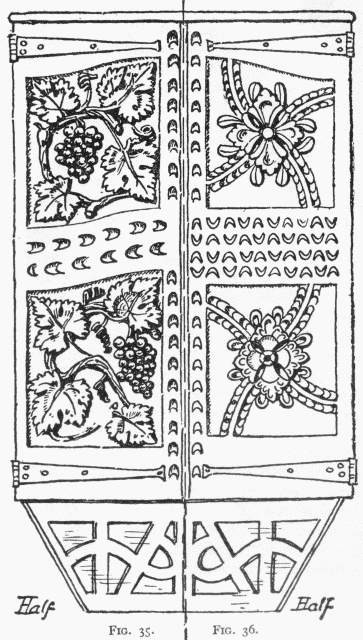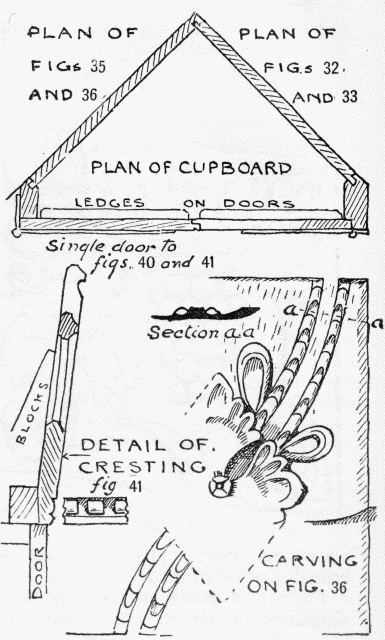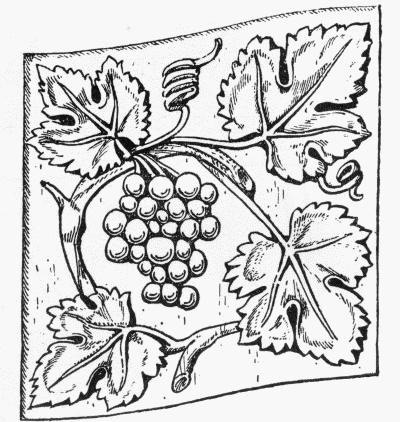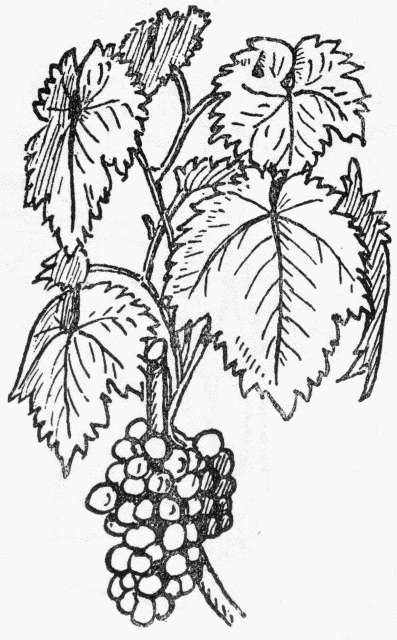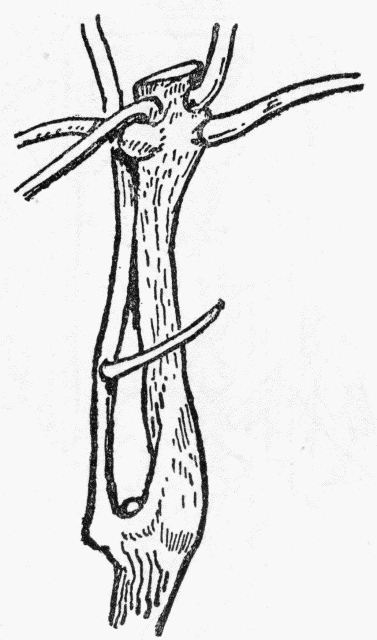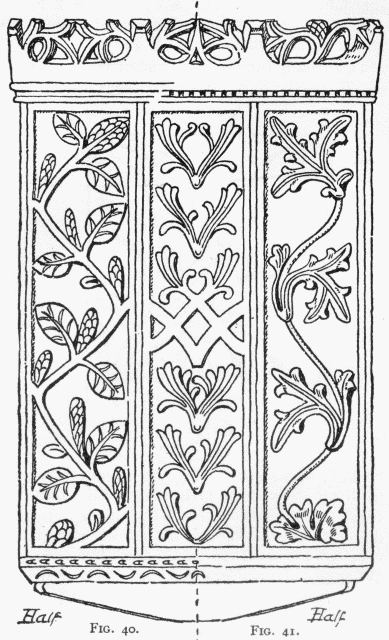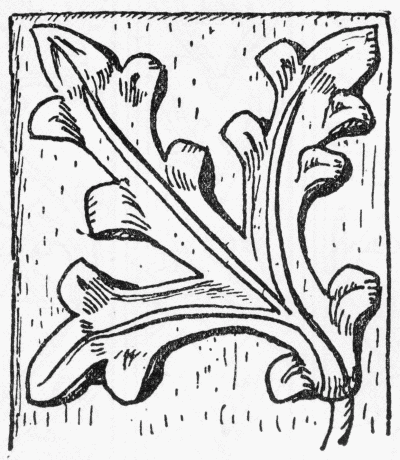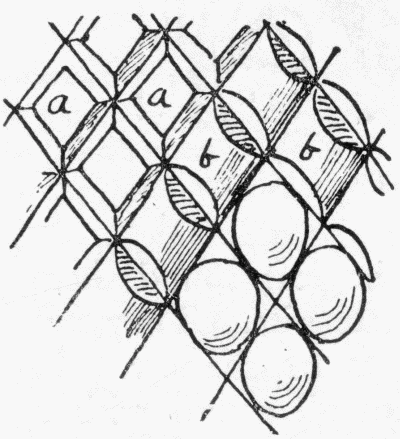CHAPTER XIV
HARDWOOD CARVING
Carvings Cannot be Independent Ornaments - Carving Impossible on Commercial Productions - The Amateur Joiner - Corner Cupboards - Introduction of Foliage Definite in Form, and Simple in Character - Methods of Carving Grapes.
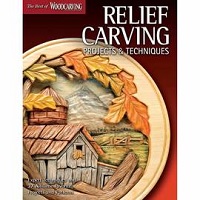


We now come to the question, what are we going to do with all the pieces of carving which we propose to undertake.
There is no more inexorable law relating to the use of wood-carving than the one which insists upon some kind of passport for its introduction, wherever it appears. It must come in good company, and be properly introduced. The slightest and most distant connection with a recognized [116] sponsor is often sufficient, but it will not be received alone. We do not make carvings to hang on a wall and be admired altogether on their own account. They must decorate some object. A church screen, a font, a piece of furniture, or even the handle of a knife.
It is not always an easy matter to find suitable objects upon which to exercise our wood-carving talents. Our furniture is all made now in a wholesale manner which permits of no interference with its construction, while at the same time, if we wish to put any carving upon it, it is absolutely essential that both construction and decoration should be considered together.
A very modest beginning may be made in adapting ornament to a useful article, by carving the surface of a bread plate. These are usually made of some hard wood, such as sycamore. They may be made of oak, but sycamore has the advantage in its lighter color, which is more likely to be kept clean. Two suggestions are given in Figs. 27 and 28 for carving appropriate to this purpose. The essentials are, that there should be a well-defined pattern simple in construction, and as effective as possible with little labor; [117] that there should be little or no rounding of surface, the design consisting of gouge cuts and incisions arranged to express the pattern. The incisions may form a regular sunk ground, but it should not be deep, or it will not be easily kept clean. Then, as in cutting bread the knife comes in contact with the surface, no delicate work is advisable; a large treatment with broad surfaces, and some plain spaces left to [118] protect the carved work, is likely to prove satisfactory in every way. A piece of sycamore should be procured, ready for carving; this may be got from a wood-turner, but it will be as well to give him a drawing, on which is shown the section of edge and the position of all turned lines required for confining the carving. If the plate is to be of any shape other than circular, then it must be neatly [119] made by a joiner, unless you can shape it yourself.
Many of you are, I have no doubt, handy joiners, and may with a little help put together some slight pieces of furniture to serve at least as an excuse for the introduction of your carving. Here are some suggestions for corner cupboards, chosen as giving the largest area for carved surface with the minimum of expense in construction. The material should be oak—English if possible, or it may be Italian walnut. The doors of Figs. 40 and 41 are in three narrow boards with shallow beads at the joints, those of the others are each made of a single board, and should be 1/2 in. to 5/8 in. thick, the doors may be about 2 ft. 6 ins. high, each having two ledges about 3 ins. wide, screwed on behind top and bottom to keep them from twisting. All moldings, beads, etc., are to be carved by hand, no planes being used. Having traced the lines of your design upon the board, you may begin, if there are moldings as in Fig. 32, by using a joiner's marking gage to groove out the deepest parts of the parallel lines in the moldings along the edges, doing the same to the curved ones [120] with a V tool or Veiner. Then form the moldings with your chisels or gouges. Keep them very flat in section as in Fig. 29. The fret patterns on Figs. 32, 35, and 36, where not pierced, should also be done in low relief, not more than 1/8 in. deep, and the sides of the bands beveled as in section a, Fig 30. The widths of these bands ought not to be less than 1/2 in., and look better if they are wider. Very narrow bands have a better appearance, if, instead of being cut straight down, they are hollowed at sides like b in Fig. 30.
Fig. 31 is a detail of a kind of gouge work which you must all know very well. One perpendicular cut of a gouge driven in with the mallet, and one side cut, should form one of these crescent or thimble-shaped holes. They should not be too deep in proportion to their size. Their [122] combinations may be varied to a great extent. Two or three common ones are shown in the illustration. This form of ornament was in all likelihood invented by some ingenious carpenter with a turn for art and a limited stock of carving tools. His humble contribution to the resources of the carver's art has received its due share of the flattery which is implied by imitation. In all these patterns it is well to remember that the flat surface of the board left between the cuts is really the important thing to consider, as all variety is obtained by disposing the holes in such a way as to produce the pattern required by means of their outlines on the plain surface. Thus waved lines are produced as in Fig. 31, and little niches like mimic architecture as in Fig. 34, by the addition of the triangular-shaped holes at the top, and the splayed sills at the bottom. (It is obvious that an arrangement like the latter should never be turned upside down.) If this attention to the surface pattern is neglected the holes are apt to become mere confused and meaningless spots.
In small pieces of furniture like these, which are made of comparatively thin [123] wood, the carving need not have much depth, say the ground is sunk 1/4 in. at the deepest. As oak is more tenacious than pine, you will find greater freedom in working it, although it is so much harder to cut. You may find it necessary to use the mallet for the greater part of the blocking out, but it need not be much used in finishing. A series of short strokes driven by gentle taps of the mallet will often make a better curve than if the same is attempted without its aid.
It will be well now to procure the remainder of the set of twenty-four tools if you have not already got them, as they will be required for the foliage we are about to attempt. The deep gouges are especially useful: having two different sweeps on each tool, they adapt themselves to hollows which change in section as they advance.
Fig. 32 contains very little foliage, such as there is being disposed in small diamond-shaped spaces, sunk in the face of the doors, and a small piece on the bracket below. All this work should be of a very simple character, definite in form and broad in treatment.
Fig. 33 is more elaborate, but on much [125] the same lines of design varied by having a larger space filled with groups of leaves. Fig. 34 gives the carving to a larger scale; in it the oak-leaves are shown with raised veins in the center, the others being merely indicated by the gouge hollows. There is some attempt in this at a more natural mode of treating the foliage. While such work is being carved, it is well to look now and then at the natural forms themselves (oak and laurel in this case) in order to note their characteristic features, and as a wholesome check on the dangers of mannerism.
It is a general axiom founded upon the evidence of past work, and a respect for the laws of construction in the carpenter's department, that when foliage appears in panels divided by plain spaces, it should never be made to look as if it grew from one panel into the other, with the suggestion of boughs passing behind the solid parts. This is a characteristic of Japanese work, and may, perhaps, be admirable when used in delicate painted decorations on a screen or other light furniture, but in carvings it disturbs the effect of solidity in the material, and serves no purpose which can not be attained in a much better way. [126]
Expedients have been invented to overcome the difficulty of making a fresh start in each panel, one of which is shown in Fig. 34, where the beginning of the bough is hidden under a leaf. It is presumable that the bough may go on behind the uncarved portions of the board to reappear in another place, but we need not insist upon the fancy, which loses all its power when attention is called to it, like riddles when the answer is known.
In Fig. 35, like the last, the treatment is somewhat realistic. This is shown to a larger scale in Fig. 38. Nevertheless, it has all been "arranged" to fit its allotted space, and all accidental elements eliminated; such, for instance, as leaves disappearing in violent perspective, or even turned sidewise, and all minute details which would not be likely to show conspicuously if carved in wood. In Fig. 39, (a) is an outline of a group of vine-leaves taken from nature, as it appeared, and in which state it is quite unfitted for carving, on account of its complicated perspective and want of definite outline; Fig. 39 (b) is a detail also copied from nature, but which might stand without alteration provided it formed part of a work delicate [129] enough to note such close elaboration in so small a space. This, of course, would entirely depend upon the purpose for which the carving was intended, and whether it was meant for distant view or close inspection. As there is arrangement necessary in forming the outline, so there is just as much required in designing the articulation of the surfaces of the leaves, which should be so treated that their hollows fall into a semblance of some kind of pattern. Fig. 36 is a more formal design, or, to use a very much abused word, more "conventional," in which such leafage as there is only serves the purpose of ornamental points, marking the divisions of the general design. The gouge work upon the leaves should be of the simplest description, but strict attention is necessary in drawing the grooves, so that their forms may be clear and emphatic, leaving no doubt as to the pattern intended. Designs of this kind have no interest whatever except as pieces of patterned work, to which end every other consideration should be sacrificed. It must not be cut too deep—say 1/4 in. at the deepest—and the sides of the panels should be very gently hollowed out with a flattish sweep (see section on Fig. 37) in [130] order to avoid any appearance of actual construction in what more or less imitates the stiles and rails of a door. Fig. 37 shows a portion of the leafage to a larger scale, and also a plan explaining the construction of all these cupboards.
Fig. 40 is designed upon the barest suggestion of natural foliage, the wavy [132] stem being quite flat, and running out flush into the flat margins at the sides, connecting them together. The leaves in this case should be carved, leaving the veins standing solid; grooved veins would have a meager look upon such rudimentary leaves. Of course a more natural [133] treatment may be given to this kind of design, but in that case it would require to be carried all over the door, and replace the formally ornamental center panel. The pierced pattern in cresting should be done as already described for Fig. 24.
Fig. 41 is a variant on the last design. In this case a little more play of surface is attempted, making a point of carving the [135] side lobes of the leaves into little rounded masses which will reflect points of light. This is shown better on Fig. 42.
In carving foliage like that of the vine, where small dark holes or eyes occur, enough wood should be left round them to form deep dark little pits. They are very valuable as points of shadow. In doing this, cut the rim all round with a very slight bevel as in section, Fig. 43. Whenever leaves run out to a fine edge [136] they also should have a small bevel like this in order to avoid an appearance of weakness which acute edges always present. As a general rule leave as much wood as possible about the edges of leaves as you want shadow from them—dipping them only where you are sure the variety will be effective. In the execution of bunches of rounded forms like grapes there is no special mechanical expedient for doing them quickly and easily; each must be cut out separately, and carved with whatever tools come handiest to their shape and size. It is a good way to begin by cutting triangular holes between the grapes with the point of a small chisel (see Fig. 44), after which [137] the rough shapes left may gradually be formed into ovals. When the work is very simple in character, and does not require a realistic treatment, the grapes may be done in a more methodical way, as in Fig. 45. First cut grooves across both ways with a V tool, dividing the grapes as at a a, then with a gouge turned hollow down round each line of grapes into rolls as at b b. Do this both ways, and afterward finish the form as best you can.

|
INFORMATION ABOUT HOW TO MAKE MONEY FROM WOOD CARVING |
